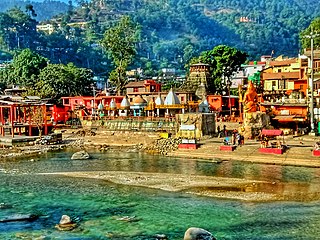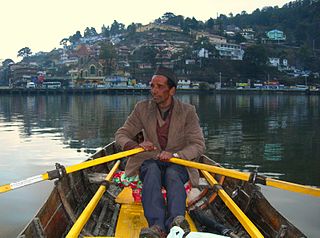Related Research Articles

Kumaoni is an Indo-Aryan language spoken by over two million people of the Kumaon region of the state of Uttarakhand in northern India and parts of Doti region in Western Nepal. As per 1961 survey there were 1,030,254 Kumaoni speakers in India. The number of speakers increased to 2.2 million in 2011.

Govind Ballabh Pant was an Indian freedom fighter and the first chief minister of Uttar Pradesh. Alongside Mahatma Gandhi, Jawaharlal Nehru and Vallabh Bhai Patel, Pant was a key figure in the movement for India's Independence and later a pivotal figure in the Indian Government. He was one of the foremost political leaders of Uttar Pradesh and a key player in the unsuccessful movement to establish Hindi as the official language of Indian Union.

Gangolihat is a town in the Pithoragarh district of Uttarakhand, India. It is the headquarters of an eponymous tehsil ~ one of the 12 revenue subdivisions of the Pithorarh district.

The Chand Dynasty, sometimes Chandel of Kumaon or Chand Kingdom, was a Hindu dynasty of Kumaon, which was established by displacing the Katyuri kings. The Chands ruled over the Kumaon and parts of the Farwestern Nepal called Doti. They belonged to the Somvanshi Chandel Yadava dynasty of Rajputs.

Bageshwar is a district of Uttarakhand state in northern India. The town of Bageshwar is the district headquarters. Prior to its establishment as a district in 1997 it was part of Almora district.

Bageshwar is a town and a municipal board in Bageshwar district in the state of Uttarakhand, India. It is located at a distance of 470 km from the National Capital New Delhi and 332 km from the State Capital Dehradun. Bageshwar is known for its scenic environment, glaciers, rivers and temples. It is also the administrative headquarters of Bageshwar district.

Almora is a municipal board and a cantonment town in the state of Uttarakhand, India. It is the administrative headquarters of Almora district. Almora is located on a ridge at the southern edge of the Kumaon Hills of the Himalaya range. The Koshi (Kaushiki) and Suyal (Salmale) rivers flow along the city and snow-capped Himalayas can be seen in the background.
Chandola is a Brahmin surname of Garhwali and Kumaoni origin mostly used in the Indian state of Uttarakhand.

Baijnath is a small town on the banks of the Gomati river in the Bageshwar district in Kumaon division of Uttarakhand, India. The place is most noted for its ancient temples, which have been recognized as Monuments of National Importance by the Archaeological Survey of India in Uttarakhand. Baijnath has been selected as one of the four places to be connected by the 'Shiva Heritage Circuit' in Kumaon, under the Swadesh Darshan Scheme of the Government of India.

Dr. Shekhar Pathak is a historian, editor, publisher, activist, and traveller from Uttarakhand, India. He is known for his extensive knowledge of the history of colonial and postcolonial social movements and contemporary environmental and social issues in Uttarakhand, and colonial exploration in the Himalayas and Tibet. He has also been engaged in activism for various social and environmental causes since the 1970s.

Kumaonis, also known as Kumaiye and Kumain, are an Indo-Aryan ethno-linguistic group who speak Kumaoni as their first-language and live mostly in Kumaon division in the state of Uttarakhand in India and parts of the Sudurpashchim Province in far western Nepal.

Kanda is a small historic town and tehsil in Bageshwar district, in the state of Uttarakhand, India.
Kapkot or Kapkote is a village in Bageshwar district, Uttarakhand, India. It houses the headquarters of Kapkot Tehsil, the largest administrative subdivision of Bageshwar district. It is known for being the last bus terminus on the route to Pindari Glacier. Kapkot is located almost 25 kilometres (16 mi) from its district headquarters at Bageshwar.

Bagnath Temple is an ancient shrine dedicated to Shiva, situated in the Bageshwar city at the confluence of Sarayu and Gomati rivers. Bagnath Temple is festooned with bells of all sizes and features impressive carvings. It is the most famous Temple in Bageshwar District. It is flooded with devotees on the occasion of Shivratri. The city of Bageshwar gets its name from this Temple.
The Uttarakhand movement refers to the events of statehood activism within the undivided state of Uttar Pradesh which ultimately resulted in the formation of Uttarakhand, India as a separate state. Uttarakhand became a state on 9 November 2000. The formation of Uttarakhand was achieved after a long struggle and many sacrifices. The demand to make Uttarakhand a state was first raised at a special session of the Indian National Congress held in Srinagar on 5-6 May 1938. The demand gradually strengthened following a series of events. In 1994, the demand for a separate state eventually took the form of a mass movement that resulted in the formation of India's 27th state by 2000. Jeet Bahadur Gurung became the first martyr in Pauri on 8 August 1994.
Pandit Badri Datt Pande was an Indian historian, freedom fighter, Social Reformer and subsequently, a Member of Parliament from Almora in independent India.

The Sarju, also known as Sarayu, is a major river draining Central Kumaon region in the Indian state of Uttarakhand. Originating from Sarmul, Sarju flows through the cities of Kapkot, Bageshwar and Seraghat before joining Mahakali at Pancheshwar. The Sarju is the largest tributary of the Sharda River. The river forms the South-eastern border between the districts of Pithoragarh and Almora. Temperate and sub-Tropical forests cover the entire Catchment area of the River.
Mankot is a Village situated in Bageshwar district in the State of Uttarakhand, India. It is located at a distance of 13.5 kilometres (8.4 mi) from Bageshwar on the National Highway 309A. Mankot is a medium-sized village with total 118 families residing.

Kautik International Student Film Festival is a 10-day competitive international student film festival, organised by CEFM-the Hermitage, Kumaun University, Nainital, Uttarakhand, in association with the Himalayan Society for Art, Culture, Education, Environment and Film Development (HIMACEEF) promoted by filmmakers/academicians Rajesh Shah and National Award winning documentary filmmaker Shalini Shah. The duo are film faculty members at the University. The festival is attended by students, theatre artistes, cinematographers, filmmakers and ministers.
References
- Pathak, Shekhar (1 September 1991). "The begar abolition movements in British Kumaun". The Indian Economic & Social History Review. 28 (3): 261–279. doi:10.1177/001946469102800302. ISSN 0019-4646. S2CID 144807588.
- "Coolie Begar and Forest Dissent". www.uou.ac.in. Uttarakhand Open University. Archived from the original on 21 July 2017. Retrieved 7 July 2017.
- "Struggle against 'kuli beggar' was launched on Uttarayani". The Tribune . Pithoragarh. 14 January 2014. Retrieved 7 July 2017.
- "Uttarayani fest to bring Kumaon, Garhwal together". The Times of India . Almora. TNN. 3 January 2015. Retrieved 7 July 2017.
- "काशीपुर में चलाया था स्वराज आंदोलन" (in Hindi). Rudrapur: Amar Ujala. 10 September 2016. Retrieved 7 July 2017.
- "1857 के गदर से आई कुमाऊं में क्रांति की लहर" (in Hindi). Almora: Dainik Jagran. 17 May 2013. Retrieved 7 July 2017.
- "रक्तहीन क्रांति का मूक गवाह है सरयू बगड़" (in Hindi). Bageshwar: Dainik Jagran. 13 January 2016. Retrieved 7 July 2017.
- "कुली बेगार उन्मूलन का माध्यम बना उत्तरायणी मेला" (in Hindi). Bageshwar: Amar Ujala. 12 January 2014. Retrieved 7 July 2017.
- "कुली उतार आंदोलन ने से मिली थी नई ऊर्जा" (in Hindi). Bageshwar: Amar Ujala. 15 August 2016. Retrieved 7 July 2017.